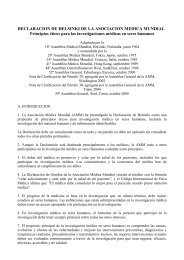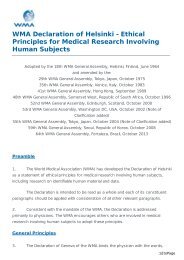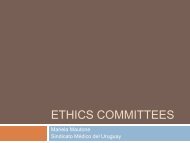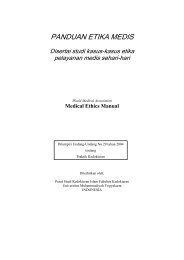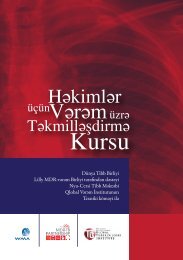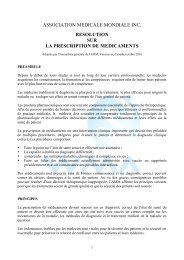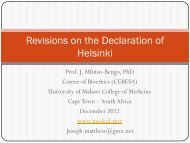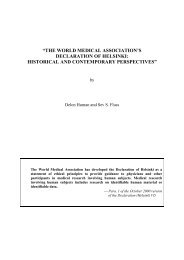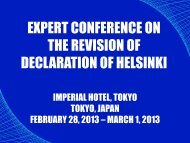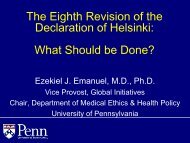WMJ 03 2010 - World Medical Association
WMJ 03 2010 - World Medical Association
WMJ 03 2010 - World Medical Association
- No tags were found...
Create successful ePaper yourself
Turn your PDF publications into a flip-book with our unique Google optimized e-Paper software.
<strong>Medical</strong> Ethics, Humam Rights, Socio-medical affairs and Environmental Policy<br />
on the topic of placebos. Its publication in<br />
a reputable specialist journal contributed to<br />
placebo controlled double blind studies gradually<br />
becoming the standard in pharmaceutical<br />
research from the 1950s onwards.<br />
In the early 1970s, placebo research took a<br />
new direction when the responder concept<br />
which claims that some people are more susceptible<br />
to placebos than others. A milestone<br />
on the way to the epistemic shift was Jerome<br />
D. Frank’s book Persuasion and Healing (1973)<br />
which focused on what is called the therapeutic<br />
setting [15]. The change in expectations is<br />
seen as a crucial mechanism with the placebo<br />
effect. According to Frank, it was simply a<br />
matter of inducing hope for improvement in a<br />
patient who was seeking help.<br />
At the end of the 1970s, placebo research<br />
moved a step further after the discovery of<br />
endorphins. An American group of scientists<br />
showed that it was possible to stimulate<br />
the release of endorphins with placebos<br />
and thus override pain receptors [30]. They<br />
were convinced that they had found the placebo<br />
effect’s mechanism of action. Almost<br />
at the same time Robert Ader and Nicholas<br />
Cohen experimented with a strain of mice<br />
that spontaneously became sick due to an<br />
overreaction of the immune system which<br />
is usually treated with immunosuppressives<br />
[1]. The two researchers were able to demonstrate<br />
that conditioning made it possible<br />
to replace the verum with sugared water,<br />
thus proving that the placebo effect cannot<br />
be reduced to a particular human interaction.<br />
At the beginning of the 1980s there was<br />
a new development. In 1983, the American<br />
anthropologist Daniel E. Moerman of<br />
Michigan University suggested replacing<br />
the term “placebo effect” by “meaning response”<br />
[37].<br />
1985 saw the first endeavours to bring<br />
the various research strands together. The<br />
American authors L. White, B. Tursky and<br />
G.E. Schwartz advocated an “integrative<br />
synthesis of all relevant views and factors” 1 .<br />
Despite some initiatives [40, 6] this synthesis<br />
remains a desideratum.<br />
References<br />
1. Ader RA, Cohen N. Behaviorally conditioned immunosuppression.<br />
Psychosomatic Medicine. 1975;<br />
37: 333–40.<br />
2. Andersen LO, Claësson MH, Hróbjartsson A,<br />
Sørensen AN. Placebo. Historie, biologi og effekt.<br />
Kopenhagen: Akademisk Forlag; 1997.<br />
3. Aronson J. When I use a word… Please, please me.<br />
BMJ. 1999; 318 : 716.<br />
4. Beecher HK. Die Placebowirkung als unspezifischer<br />
Wirkungsfaktor im Bereich der Krankheit<br />
und der Krankenbehandlung. In: Placebo – das<br />
universelle Medikament Mainz: Paul-Martini-<br />
Stiftung; 1984. P. 25–42.<br />
5. Beecher HK. The powerful placebo. JAMA. 1955;<br />
159 :1602–6.<br />
6. Benedetti F. Placebo effects : understanding the<br />
mechanisms in health and disease, New York: Oxford<br />
University Press; 2009.<br />
7. Bolte J. Placebo singen. Korrespondenzblatt des<br />
Vereins für niederdeutsche Sprachforschung.<br />
1885; 10 :19–20.<br />
8. Craen T. Placebo and placebo effects in clinical<br />
trials. Academisch proefschrift Universiteit van<br />
Amsterdam; 1998.<br />
9. Cullen W. Clinical Lectures 1772 Feb/Apr<br />
RCPE Manuscript Cullen 4/4 218–9 (Faksimile:<br />
http://www.jameslindlibrary.org/trial_<br />
records/17th_18th_Century/cullen/culle/n-kp.<br />
html, letzter Zugriff 17.10.2007)<br />
10. Cullen W. Clinical Lectures 1772-3 RCPE Manuscript<br />
Cullen 4/2 299-300 ( Faksimile: http://www.<br />
jameslindlibrary.org/trial_records/17th_18th_<br />
Century/cullen/cullen-kp.html, letzter Zugriff<br />
17.10.2007)<br />
11. Dean ME. A homeopathic origin for placebo controls:<br />
An invaluable gift of God. Alternative Therapies<br />
in Health and Medicine. 2000;6 : 58–66.<br />
12. Dean ME. An innocent deception: placebo controls<br />
in the St Petersburg homeopathy trial, 1829-<br />
30 (20<strong>03</strong>). The James Lind Library (www.jameslindlibrary.org,<br />
letzter Zugriff 17.10. 2007).<br />
13. Dean ME. The trials of homeopathy: origins,<br />
structure and development. Essen: KVC-Verlag;<br />
2004.<br />
14. Fisher RA. The design of experiments. Edinburgh:<br />
Oliver and Boyd; 1935.<br />
15. Frank JD. Persuasion and healing: a comparative<br />
study of psychotherapy. Rev. ed. Baltimore: Johns<br />
Hopkins University Press; 1973.<br />
1. White LB, Tursky B, Schwartz GE. Placebo.<br />
Theory, Research and Mechanisms. New York:<br />
Guilford Press; 1985. P. 446.<br />
16. Gold H, Kwit NT, Otto H. The xanthines (theobromine<br />
and aminonphylline) in the treatment of<br />
cardiac pain. JAMA. 1937; 108: 2173–79.<br />
17. Hahnemann S. Die Chronischen Krankheiten. 2.<br />
Aufl., Bd. 1. Leipzig: Arnold; 1835.<br />
18. Hahnemann S. Heilart des jetzt herrschenden<br />
Nerven- oder Spitalfiebers (1814). In: Hahnemann<br />
S. Kleine Medizinische Schriften, hrsg. von<br />
Schmidt J M., Kaiser D. Karl F. Haug. Stuttgart:<br />
Verlag; 2001.<br />
19. Haygarth J. Of the Imagination, as a Cause and<br />
as a Cure of Disorders of the Body; Exemplified<br />
by Fictitious Tractors and Epidemic Convulsions.<br />
Bath: R. Cruttwell; 1801.<br />
20. Herrmann J. Amtlicher Bericht des Herrn D. Herrmann<br />
über die homöopathische Behandlung im<br />
Militärhospitale zu Tulzyn in Podolien, welche er<br />
auf Befehl Sr. Maj. des Kaisers Nicolaus I. unternommen;<br />
nebst einer Abhandlung über die Kur<br />
der Wechselfieber. Annalen der homöopathischen<br />
Klinik. 1831; 2: 380–99.<br />
21. Hieronymus. Epistola CVI Ad Sunniam et Fretelam:<br />
“Placebo Domino in regione vivorum [..] pro<br />
quo in Graeco legisse vos dicitis: Placebo in conspectu<br />
Domini. Sed hoc superfluum est.” (http://<br />
patrologia.narod.ru/patrolog/hieronym/epist/<br />
epist04.htm, letzter Zugriff 19.10.2007)<br />
22. Hill AB. Suspended judgment: memories of the<br />
British streptomycin trial in tuberculosis. the first<br />
randomized clinical trial. Controlled Clinical Trials.<br />
1990;11: 77-9.<br />
23. Holtz [Ziegeleibesitzer] an Dr. Samuel Hahnemann,<br />
Brief vom 8.9.1832, Archiv des Instituts für<br />
Geschichte der Medizin der Robert Bosch Stiftung,<br />
Stuttgart, Bestand B 321150.<br />
24. Jacobs B. Biblical origins of placebo. Journal of the<br />
Royal Society of Medicine. 2000; 93: 213–4.<br />
25. Jefferson T. Brief vom 21.6.1807 an Dr. Caspar<br />
Wistar. http://www.iupui.edu/~histwhs/h364.dir/<br />
jeffwistar.html (letzter Zugriff 8.11.2007).<br />
26. Jütte R. Geschichte der alternativen Medizin. Von<br />
der Volksmedizin zu den unkonventionellen Therapien<br />
von heute. München: C. H. Beck; 1996.<br />
27. Kaptchuk T J. Intentional ignorance: a history of<br />
blind assessment and placebo controls in medicine.<br />
Bulletin of the History of Medicine. 1998;<br />
72: 389–433.<br />
28. Kerr CE, Milne I, Kaptchuk TJ. William Cullen<br />
and a missing mind-body link in the early history<br />
of placebos. The James Lind Library (www.jameslindlibrary.org,<br />
letzter Zugriff 8.10.2007).<br />
29. Kienle GS. Der sogenannte Placeboeffekt. Illusion,<br />
Fakten, Realität. Stuttgart; New York: Schattauer;<br />
1995.<br />
30. Levine JD, Gordon NC, Fields HL. The Mechanism<br />
of Placebo-Analgesia. Lancet. 1978; 2:<br />
654–7.<br />
31. Lichtenstädt J. Beschluss des Kaiserl. Russ. Menicinalraths<br />
[sic] in Beziehung auf die homöopathische<br />
Heilmethode. Litterarische Annalen der<br />
gesammten Heilkunde. 1832; 24: 412–20.<br />
113



